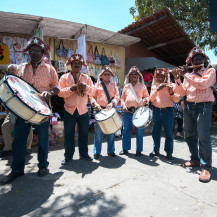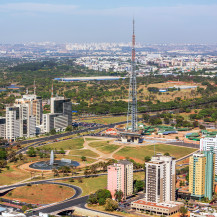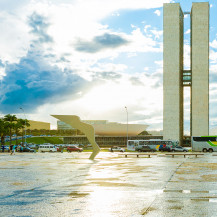Park-City, Hope Capital
Brasilia was inaugurated by president Juscelino Kubitschek. The new capital was an audacious plan and acquired the status of 20th century urban planning and modern architecture symbol.
Brasilia is Brazil's 3rd capital. The first one was Salvador, in Bahia State, and then the city of Rio de Janeiro. The idea behind building a new capital was to populate the center of the country, as well as to keep the capital protected from possible sea attacks.
The city
Brasilia, with almost 2.5 million inhabitants, had its basic design, called Plano Piloto, idealized by urbanist Lucio Costa and architect Oscar Niemeyer. The design resembles a plane and has been listed by UNESCO as a World Cultural Heritage site. It is the city with the largest heritage area in the world - 112.5 square kilometers.
Plano Piloto is formed by the encounter of two axis, Eixo Monumental and Eixo Rodoviario, embraced by the Paranoa Lake. Eixo Monumental has many attractions: the Praça dos Três Poderes (Three Powers Square), the Palácio do Planalto (Planalto Palace), the Congresso Nacional (National Congress), the Catedral Metropolitana de Brasília (Brasilia’s Metropolitan Cathedral) and the Torre de TV (TV Tower). Along Eixo Rodoviário are the residential blocks, divided between Norte (North) and Sul (South).
In Brasilia, every building must obey characteristics that are predetermined in the Lucio Costa project. Residential buildings, for instance, are sustained only by columns and have their pilotis open to extensive green areas.
The Parque da Cidade Dona Sarah Kubitschek, best known as the City Park, is one of the main centers of open air leisure in the capital. It has 420 hectares and is one of the biggest urban parks in the world. It also has sports courts, amusement parks, an artificial lake, barbecue grills, an equestrian center and jogging routes.
The Paranoa Lake, which has a lake shore with excellent restaurants and bars, brings water sports athletes together on the weekends to practice sports like Stand Up Paddling (SUP), canoeing and kitesurfing.
What about visiting the architectonic and urban beauties of Brasilia? Check here a city tour.
-
Plane/airport
International flights from seven different cities arrive at the
International Airport Juscelino Kubitschek: Buenos Aires, Atlanta, Paris, Miami, Lisbon, Panama and Punta Cana.
Address: Area Especial – Lago Sul
+55 (61) 3364-9000
Official website.
Road (bus)
Brasilia Interstate Bus Terminal has 39 operating companies.
SMAS, Trecho 4, Conjunto 5/6 – Asa Sul – Brasília – Distrito Federal
+55 (61) 3234-2185
Official website. -
Bicycle
One of the best ways to get around in Brasília is by bike. You can rent bikes in several places in the city using the app Bike Basilia, available in Portuguese, English and Spanish for iPhone, Android and Windows Phone.
Subway/Train
The Metro-DF subway has 24 operating stations, it is accessible for persons with disabilities and allows bicycles on the last car.
Official website.
Subway map.
Táxi
The most comfortable way to get around the city is by taxi. Check the rate and choose a company that provide this service.
-
In order to enter Brazil, no vaccines are mandatory. However, it is recommended to take a shot against yellow fever (disease transmitted by the bite of contaminated mosquitos) before your visit. In case you have never taken the vaccine before, you should take it 10 days before your trip (this waiting period is not necessary in case you have been vaccinated before).
-
Brasilia's area code is 61.
-
Voltage: 220V
-
The weather in Brasilia is usually divided into two very fixed seasons: dry season (May to September) and rain season (October to April).
Must-see Attractions
Experiences
See our recommendations
-
Craft fairs for you to return home with a full suitcase
-
The excitement of the Brazilian nights
-
4 parks to skateboard in the main capitals of Brasil
-
Football is in the genes of the Brazilian people
-
12 shopping centers for you to return home with full suitcases
-
Cultural traditions that make Brazil a unique place
-
Four locations in Brazil that allow sensorial experiences


